Or at least a brutal challenge. Not just because it’s increasingly difficult to think of new features, but also because the phone makers have pretty much run out of room for new components inside.
That, says Apple, is why it removed the headphone jack from the iPhone 7 and 7 Plus, which go on sale Friday. The headphone jack may not seem very big — but on the inside of the phone, the corresponding receptacle occupies an unnerving amount of nonnegotiable space.
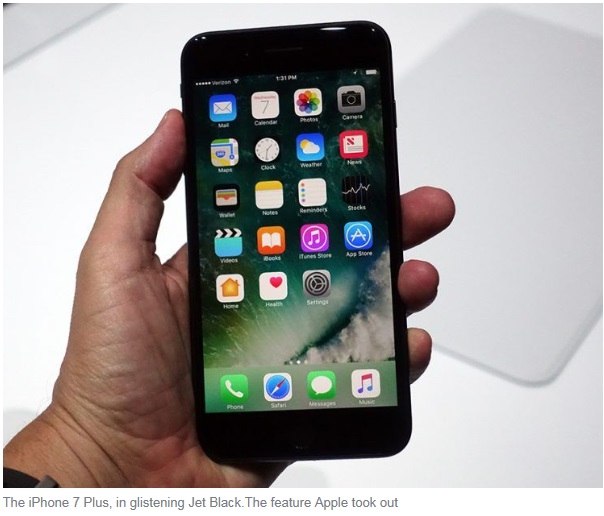
The feature Apple took out
So how are you supposed to listen to music without a headphone jack? Apple offers three ways. First, in the box, Apple includes a two-inch adapter cord that connects any headphones to the phone’s Lightning jack.
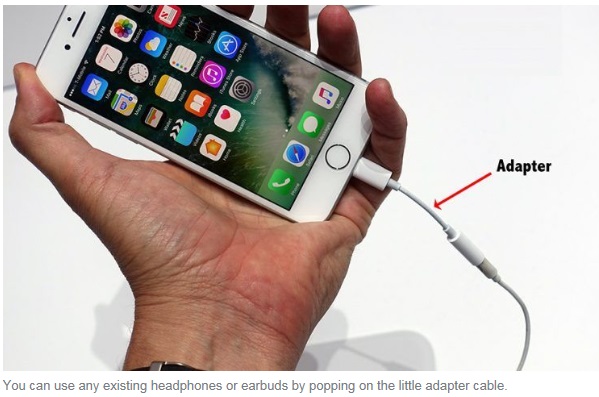
Second, the phone also comes with new white earbuds that connect to the Lightning jack. Or you can use any Bluetooth wireless earbuds, including Apple’s own, super-impressive AirPods.
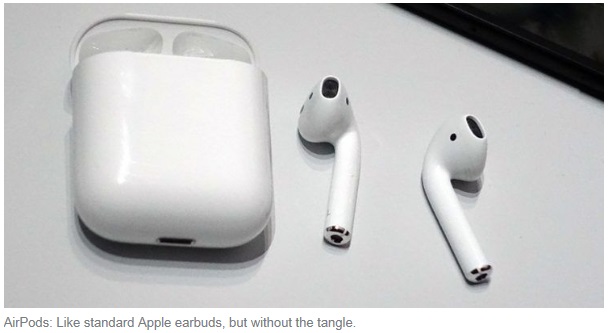
In theory, those three approaches should pretty much cover you whenever you want to listen. In practice, though, you’ll still get zapped by the occasional inconvenience bug. You’ll be on a flight, for example, listening to your laptop with headphones — and when you want to switch to the phone, you’ll realize that your adapter dongle is in the overhead bin. (Actual example.)
But this kind of hassle is the new reality. Motorola and LeEco (in China) have already ditched the headphone jack, and other phone makers will follow suit.
All right, Apple removed the headphone jack so that it could dedicate interior space to new features. What are they?
Turns out that just about every element of a smartphone that can be improved, Apple has upgraded: the case, the battery, camera, screen, speakers, processor, storage, the Home button, and the software.
The case
The back of the iPhone 7 is aluminum, whose gracefully rounded edges blend smoothly into the glass of the screen. No change there.
But in addition to the standard metal colors (matte black, silver, gold, pink gold), there’s a new finish available called Jet Black. It’s glistening, shiny, deep piano black. It’s gorgeous and sleek and smooth and you want to rub it like it’s a worry stone. It’s also slippery and fingerprinty.
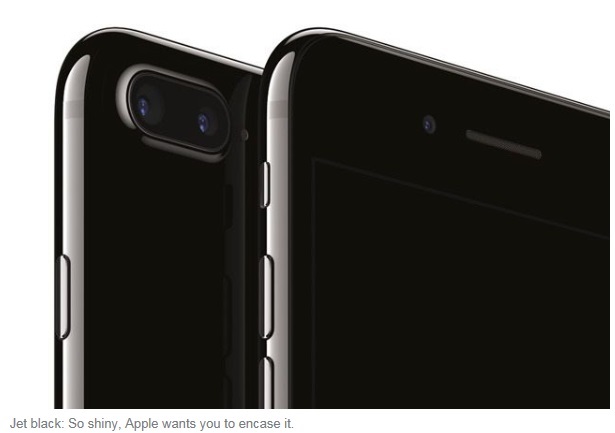
And get this: Apple warns that “its high shine may show fine micro-abrasions with use,” so it suggests that “you use one of the many cases available to protect your iPhone.”
OK what? Why would you choose a phone for its finish and then immediately bury it in a case? What am I missing?
There is, however, one big new case feature: The iPhone is, at long last, water resistant. It can handle up to 30 minutes under a meter of water. Which means that rain and falls into the toilet can’t hurt it. (I gave my test unit four drops into a mixing bowl of water, as you can see in the video above. It never even stopped playing music, and still works perfectly.)
Apple’s late to this ball game, but it’s a really good ball game.
The battery
The iPhone 7 battery is 14% larger than the previous model’s — two hours more life per charge, says Apple — and you notice it. My iPhone 6 is usually gasping along with 9% charge by bedtime; the iPhone 7 usually has around 40% left at day’s end. (The improvement in the larger Plus model is more modest: one extra hour per charge.)
Battery-life improvement may not have the dazzle of, say, a built-in laser or thought-recognition software, but it’s one of the most important enhancements Apple could have made. If you forgot to charge your phone last night, no biggie — you’ll have until midday to find a charge.
Apple is too modest to point out another advantage of the iPhone 7’s battery, too: As far as we know, it doesn’t catch fire, and flight attendants don’t make announcements that ban your phone model in flight (*cough* Samsung Note 7 *cough*).
The camera
Apple makes a big deal of the iPhone 7’s new camera. It’s got 12 megapixels, and the front camera has been goosed to 7 megapixels. Megapixel don’t really mean very much, though; they have no effect on picture quality.
Apple also raves about the camera’s f/1.8 aperture (lets in a lot of light). But you know what? When the light is good, the shots look exactly the same as they did on the last couple of iPhone models. (In some photos, you do see slightly richer colors, but only when you view those photos on the iPhone 7’s enhanced screen, as described below.)



The new camera shows its value primarily in low light. The stabilized lens helps a lot — an internal shock absorber that counteracts the typical tiny hand jiggles that often introduce blur into low-light photos. (This feature, which also does a great job of stabilizing videos, used to be only in the Plus-sized phones; the smaller iPhone 7 has room for it, Apple says, only because of the removal of the headphone jack.)
All of this makes a huge difference in low-light videos. The color is clearer, and the graininess much less pronounced. Low-light stills are enhanced to a lesser degree.
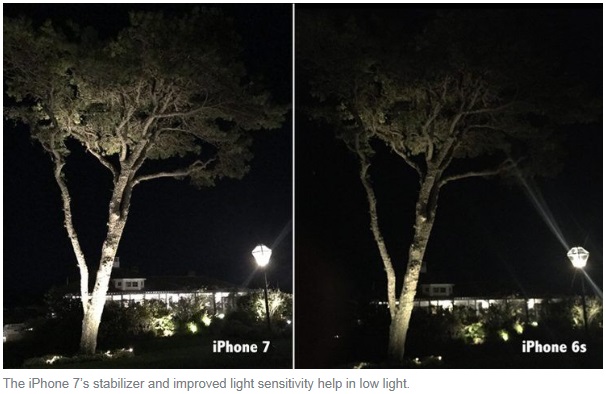
The flash on the back is now made up of four LEDs instead of two, resulting in flashes (and flashlights) that are 50% brighter than before. OK, good.
On the iPhone 7 Plus, though, the camera enhancement is much bigger: Apple has installed two lenses. One is wide-angle, one is telephoto. With a tap on the screen, you zoom in 2X. This is true optical zoom, not the cruddy digital zoom on most previous phones (which just blows up the image, degrading the quality).
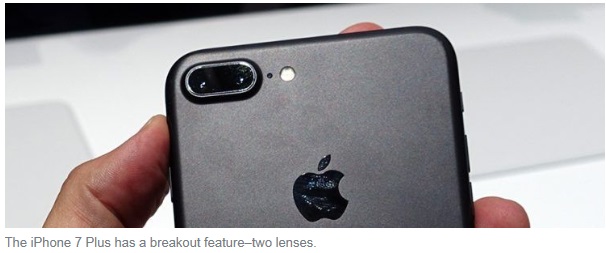
You can also dial up any amount of zoom between 1X and 2X; the iPhone performs that stunt by seamlessly combining the zoom lens’s image (in the center of the photo) with a margin provided by the wide lens.
2X zoom isn’t a huge amount, but it’s 2X as much as any other thin smartphone can handle. And it’s a triumphant first step toward eliminating a key drawback of phone cameras: They can’t actually zoom. (The LG G5 tried a similar stunt, but the second lens had only half the resolution of the first, and you couldn’t do that intermediate zooming thing.)
You can even zoom right in the middle of shooting a video, which is very cool. Occasionally, the two lenses produce different color tones for the same scene; you can it in the video above, and in the grass in this still photo.

Even on the Plus, by the way, you can continue to use the digital zoom beyond the 2X, all the way up to a somewhat blotchy 10X (or 6X for video).
In a software upgrade this fall, Apple says that the 7 Plus will gain the ability to create the gorgeously soft-focused background that’s common in professional photography. It’s not real shallow depth of field; it’s a special effect, a filter.

When Samsung tried this a couple of years ago, the result was a disaster; the blurriness could spill horribly onto the subject’s face like some kind of reverse acid bath. But on the 7 Plus, the dual cameras are supposed to let the software perfectly pick the subject apart from the background, creating a defocused background that’s indistinguishable from the one you get from “real” cameras.
The screen
Apple makes much of the iPhone 7’s new screen with its “expanded color gamut,” meaning that it can display more colors than previous screens, and its “25% brighter” display.
In truth, the difference is very subtle. You can barely identify the brighter screen only when it’s side-by-side with last year’s model and both are at full brightness.
To test the expanded color palette, I took a series of photos with the iPhone 7 and copied them to an iPhone 6s. In side-by-side taste tests, my test panelists usually identified slightly richer colors when those photos appeared on the iPhone 7’s screen.
The bottom line: Don’t expect some jaw-dropping image improvement in screen quality.
The speakers
The iPhone now has stereo speakers! They’re at the top and bottom of the phone, so you don’t get the stereo effect unless the phone is sitting sideways. Even then, there’s very little left/right channel separation.
But never mind that: The iPhone 7’s audio system overall is definitely better than before. It may not be twice as loud, as Apple claims, but you’d definitely say that the 7 sounds fuller and stronger than previous models.
The processor
This year’s iPhone processor has four cores (brains), two of which are dedicated to lower-importance tasks (and consume less power—one of the reasons the phone gets better battery life).
The storage
The pathetically small 16-gigabyte iPhone has finally gone to the great junk drawer in the sky. Now, the three iPhone storage capacities are 32, 128, and 256 gigabytes (for $650, $750, and $850; installment and rental plans are available). For the larger 7 Plus model, the prices are $770, $870, and $970.
The Home button
The Home button, central to so many iPhone features — waking the phone, switching apps, commanding Siri, and so on — is no longer a moving, mechanical part. Now, when you press it, you feel a click, but it’s actually a sonic fake-out, a sharp internal vibration.
The advantage of this setup: You can adjust how clicky the button is. There’s no gap for water to get in. And this Home button is pressure-sensitive — it knows when you’re pressing harder — which could someday permit some cool new features nobody’s even thought of yet.
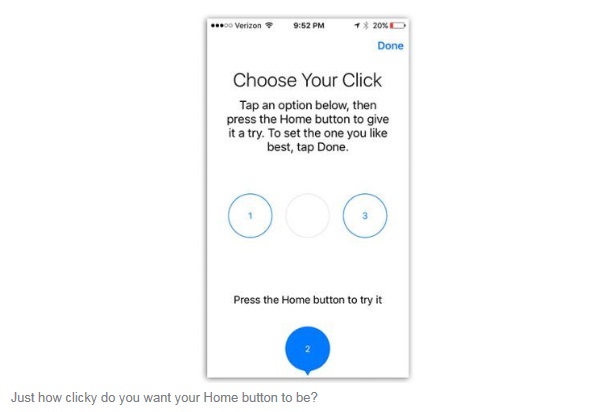
The disadvantage of this setup: When your phone is locked up, you can no longer hold down the Sleep + Home buttons to force-restart it. Instead, you’re now supposed to use Sleep + Volume Down, just as on many Android phones.
The software
The iPhone 7 comes with iOS 10, a new version of the iPhone’s operating software — and, as its usual gift to its fans, Apple offers iOS 10 as a free upgrade to anyone with a recent iPhone model. You can download it today.
There are a lot of changes in iOS 10; you can read my review of it tomorrow. Most of them represent delightful advances in efficiency and common sense; for example, you no longer have to swipe horizontally across the screen to unlock it. Instead, you press the Home button, where your thumb is already sitting (because you used the fingerprint reader). Brilliant.
The bottom line
In recent years, Apple isn’t always the technology leader in phones. This year, once again, some of the best new features are just catching up to rival phones: water resistance, image stabilization, stereo speakers. Believe it or not, Apple isn’t even the first company to take out the headphone jack.
But catch-up has value of its own, and every company plays it. (And that camera-zoom thing on the 7 Plus is fantastic.)
Now that Apple’s phone is every bit as advanced as any of its rivals, and more advanced in some areas, its engineers can finally get a well-deserved break. But only for a weekend. On Monday, it’ll be time to start dreaming up new features for next year’s iPhone.

